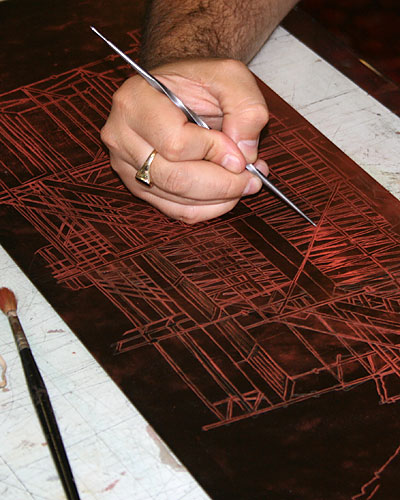

Printer's proofs are customarily given to the printmaker and signed by the artist as part of the payment due to the printmaker, in addition to any monetary fees agreed upon. For example, a print edition may include 50 signed prints, 5 Printer's Proofs and 5 Artist Proofs. They may be sold or given away at the artist's discretion and are counted in addition to the total number of prints in the edition. The intaglio process is the reverse of the woodcut technique of printing because the incised lines of the design take the ink and show up as positive images in the print.Īrtist Proofs are prints kept by the artist from the edition which may or may not have slight variations or imperfections in them. Etching uses chemicals to achieve a similar result.
Intaglio printing process manual#
Engraving and drypoint are manual techniques. There are two different ways to do this: manually or chemically. Intaglio is a graphic arts technique that involves incising or scratching a design onto a metal plate. Tarlatain is best suited for wiping when shaped into a flat pad. Hang to dry, then pull apart, to make maleable. Drain and wring out the fabric, but do not re-rinse. We at Intaglio Editions specially treat the tarlatan we use to wipe our plates by taking lightly starched tarlatan, and soaking it in a bath of warm water for 15-20 minutes, agitating every few minutes.


Tarlatan comes in several different levels of starchiness. It is used to distribute ink across the surface, and into the microscopic pits or incisions in the printmaking plate. Tarlatan is cheese cloth fabric that has been treated with starch, to give it structure. Retroussage is a technique used in traditional etching and engraving that involves drawing ink up from within the incised lines of an ink plate by passing a soft cloth or tarlatan across its surface to spread it into the adjacent area. This can be done in conjunction with using tarlatan to distrubute the ink naturally and evenly, as desired. The printmaker blends ink on the plate, in a localized manner, using a ball-shaped wad of felt, or some other fabric tool. The final image will be determined by the design and ink color, the color and opacity of the paper on which the image is printed, and the color of the backing sheet itself.Ī la poupee is an intaglio printmaking technique that allows one to apply different colored inks in different areas of the plate manually. This printmaking method also allows for a background color that is different from the surrounding backing sheet. Thin Japanese papers are especially compatible with this method. This allows the printmaker to print onto more delicate surfaces and to pull finer details off the plate. Having a reference print allows the printmaker to spot check prints during production to ensure the colors and wiping techniques are consistent, and an identical set of prints is produced.Ĭhine colle is a printmaking technique in which the image is transferred to a surface that is bonded to a heavier support during the printing process. Assignment of a Bon a Tirir indicates the end to the proofing session, which can sometimes take many iterations to get the ink color and methods of wiping just right.

It is decided upon by the Artist and Printmaker during the proofing stage. Polymer photogravure is distinct from the more generic term "photo etching", where the intent is more to achieve anything recognizable as a photograph, rather than creating one with intentional elegance requiring technical skill.įrench for the phrase "Good to Work", the Bon a Tirir is the master proof referenced when printing an edition to ensure each print matches closely to the master. Polymer Photogravure is a term coined by David Hoptman around 2003 to describe polymer plates with the goal of getting more continuous tone from them, akin to traditional photogravure in copper. The process was brought to popularity in the early 1900's, primarily thanks to the work of photographer and anthropologist Edward S. Photogravure has historically been among the most difficult and expensive traditional printmaking processes to master. This type of intaglio print can produce the continuous tones and sharp details associated with photographs. The prepared plate is then exposed to a film positive under industrial ultra-violet light, before being etched. This light-sensitive coating is prepared to first recieve ink by treating it with an aquatint, according to the platemaking method being used. Using this method, a metal plate gets coated with photosensitive medium. Sometimes loosely referred to as photo etching, the photogravure process creates a type of intaglio print.


 0 kommentar(er)
0 kommentar(er)
